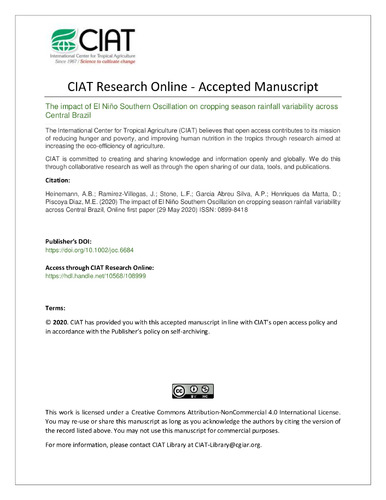The impact of El Niño Southern Oscillation on cropping season rainfall variability across Central Brazil
Local‐level understanding of within‐season rainfall variability and its relationship with the El Niño Southern Oscillation (ENSO) can shed light on crop yield variations and establish appropriate cropping calendars in rainfed systems. This requires information on the growing season, including its length, the total rainfall, the onset and cessation of rainfall, the number of wet and dry days, and the optimal sowing window. The objective of this study was to examine the onset and cessation of both the rainy and growing seasons using historical daily rainfall datasets (1980–2013) from 50 weather stations distributed across the main grain production region of Brazil. We then correlated the interannual variability of the climate variables and crop water availability with ENSO (using the Oceanic Niño Index, ONI). Across the study region, the onset of the rainy period ranged from late September to early November, and the cessation period ranged from late March to mid‐April. The onset of the growing season followed that of the rainy season, beginning across central and northern Mato Grosso in mid‐October, followed by Goiás and Tocantins, and finally Rondônia by the end of October. The length of the sowing window was reduced, and the mean optimal sowing date was delayed during La Niña years for most weather stations in the study region. Our results infer the need to adjust the cropping calendars for specific ENSO phases only in regions that conduct crop rotations. Based on rice crop model simulations of water availability, we propose a mean optimal crop sowing calendar for annual crops in Central Brazil.We analysed the impact of El Niño Southern Oscillation (ENSO) on the growing season characteristics of Central Brazil. The length of the sowing period is markedly reduced during La Niña years across the region.We analysed the impact of El Niño Southern Oscillation (ENSO) on the growing season characteristics of Central Brazil.The length of the sowing period is markedly reduced during La Niña years across the region.We propose a mean optimal crop sowing calendar for Central Brazil based on crop modelling results of ENSO effects.

